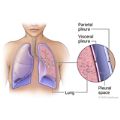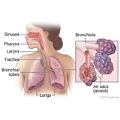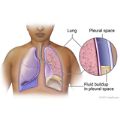pleurisy
conditions basics
what is pleurisy?
pleurisy is swelling (inflammation) of the thin layers of tissue (pleura) covering the lungs and the chest wall.
the outer layer of the pleura lines the inside of the chest wall, and the inner layer covers the lungs. the tiny space between the two layers is called the pleural cavity. this cavity normally contains a small amount of lubricating fluid that allows the two layers to slide over each other when you breathe.
when the pleura becomes inflamed, the layers rub together, causing chest pain. this is known as pleuritic pain.
pleurisy is sometimes called pleuritis.
what causes it?
in young, healthy people, an infection of the lower respiratory system by a virus or bacteria may cause pleurisy. pleurisy usually lasts a few days to 2 weeks. in very rare cases, the virus or bacteria may spread and cause pleurisy in others.
other causes of pleurisy include air leaking into the pleural cavity from a hole in a lung (pneumothorax), injury to the chest (such as a broken rib), tuberculosis or other infections, or a tumour in the pleura.
other conditions may also cause pleurisy. these include rheumatoid arthritis, lupus, sickle cell crisis, pulmonary embolism, or pancreatitis. pleurisy may also develop as a complication of heart surgery.
what are the symptoms?
the symptoms of pleurisy are chest pain and difficulty breathing. the chest pain usually starts suddenly. people often describe it as a stabbing pain, and it usually gets worse with breathing. the pain:
- may always be present, but it usually gets worse when you breathe in. you may avoid breathing deeply to prevent the pain.
- usually is on only one side of the chest.
- may extend to a shoulder or the belly.
- is usually worse when you cough, sneeze, or suddenly move.
- may ease when you hold your breath or press on the painful area.
but this type of chest pain can be caused by conditions that do not affect the pleura, such as chest muscle strain and costochondritis.
if a viral infection is causing your pleurisy, you may or may not have common viral symptoms, such as fever, headache, and muscle aches.
the inflammation of the pleura sometimes causes fluid to build up in the pleural cavity (pleural effusion). you may have less pain after this happens, because the fluid prevents the two layers of the pleura from rubbing together. if there is a large amount of fluid, it may prevent the lung from expanding when you breathe in. this can make it hard to breathe. other symptoms of pleural effusion include fever, chest pain, and a dry cough.
pleural effusion may occur without pleurisy in other conditions, such as heart failure or liver or kidney disease.
how is it diagnosed?
many different health problems can lead to pleurisy, so your doctor will look for what is causing your inflammation. the doctor will do a physical exam and tests, such as a chest x-ray, blood tests, or a ct scan, to look for the cause of your symptoms. the conditions that may cause pleuritic chest pain include:
- viral infections.
- chest muscle strain.
- rib fracture.
- blood clots in the blood vessels of the lung (pulmonary embolism).
- inflammation around the heart (pericarditis).
- pneumonia.
- tuberculosis.
- fluid in the pleura (pleural effusion).
if your doctor thinks your pleurisy may be caused by an autoimmune disease such as lupus or rheumatoid arthritis, blood tests may be done.
if you have pleural effusion, your doctor may use a needle to remove some of the fluid from the pleura. this procedure is called thoracentesis. the fluid is then studied, to help your doctor find out the cause of the effusion.
how is pleurisy treated?
the treatment for pleurisy depends on the cause. for example, if a bacterial infection is the cause, you will probably need an antibiotic. if a pulmonary embolism is present, you may get medicine to dissolve the clot or to prevent future blood clots (anticoagulants).
for most cases of pain caused by pleurisy, your doctor will suggest that you use aspirin, ibuprofen, or another non-steroidal anti-inflammatory drug (nsaid). do not give aspirin to anyone younger than 18 because of the risk of reye syndrome. if you have severe pain, you may need prescription cough or pain medicine. you may also be able to relieve pain by lying on the painful side or pressing a pillow against it.
if you have pleural effusion, you may need to have the fluid drained through a tube that the doctor inserts in your chest.
in some cases of pleural effusion, you may need pleurodesis. during this procedure, a medicine is put into your chest cavity, which triggers an inflammatory reaction over the surface of the lung and inside the chest cavity. this causes the surface of the lung to stick to the surface of the chest cavity, which prevents more fluid from building up or reduces the amount of fluid.
credits
current as of: august 6, 2023
author: healthwise staff
clinical review board
all healthwise education is reviewed by a team that includes physicians, nurses, advanced practitioners, registered dieticians, and other healthcare professionals.
current as of: august 6, 2023
author: healthwise staff
clinical review board
all healthwise education is reviewed by a team that includes physicians, nurses, advanced practitioners, registered dieticians, and other healthcare professionals.



